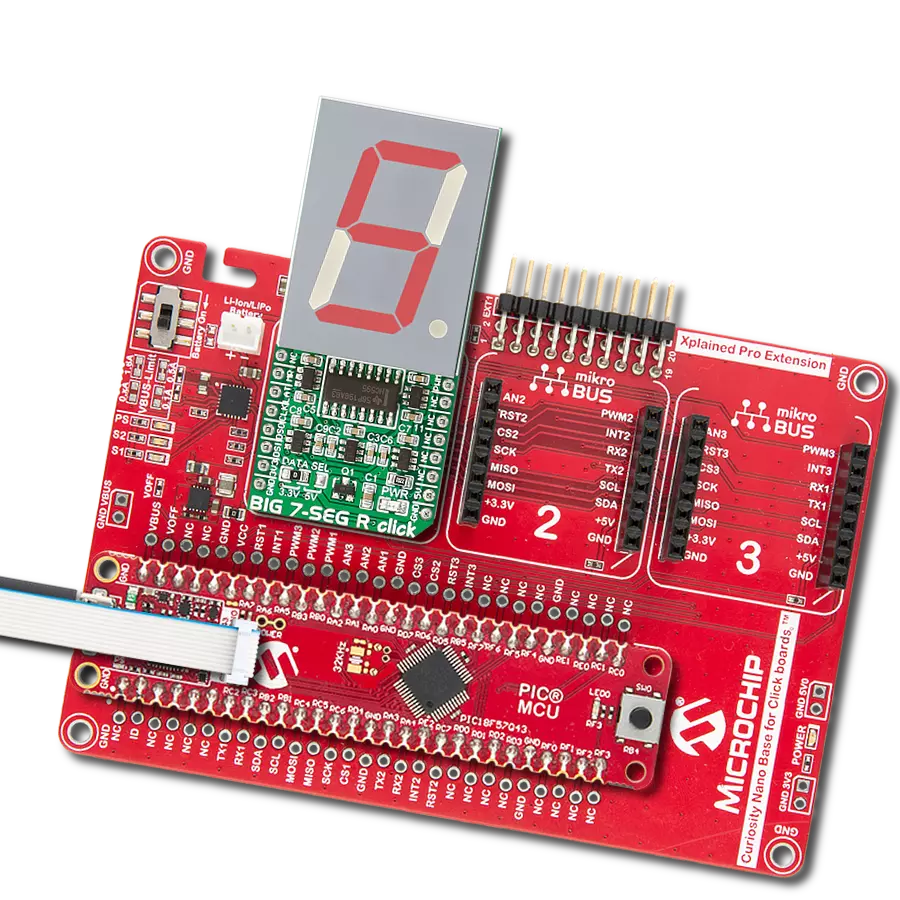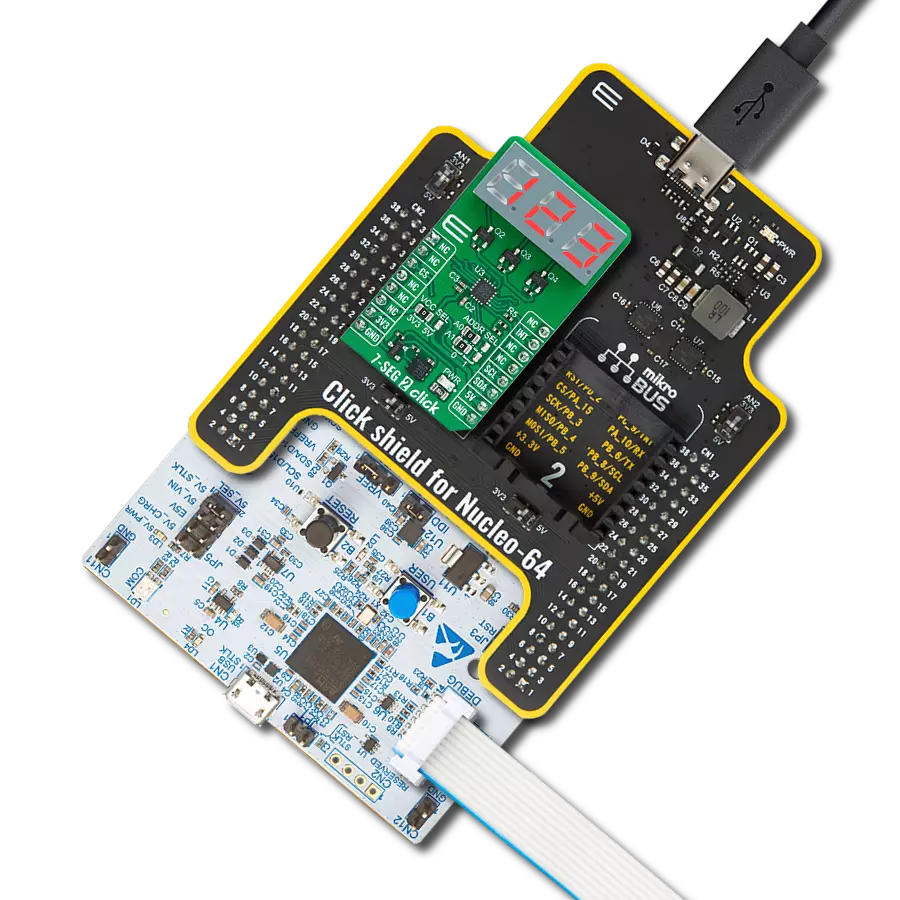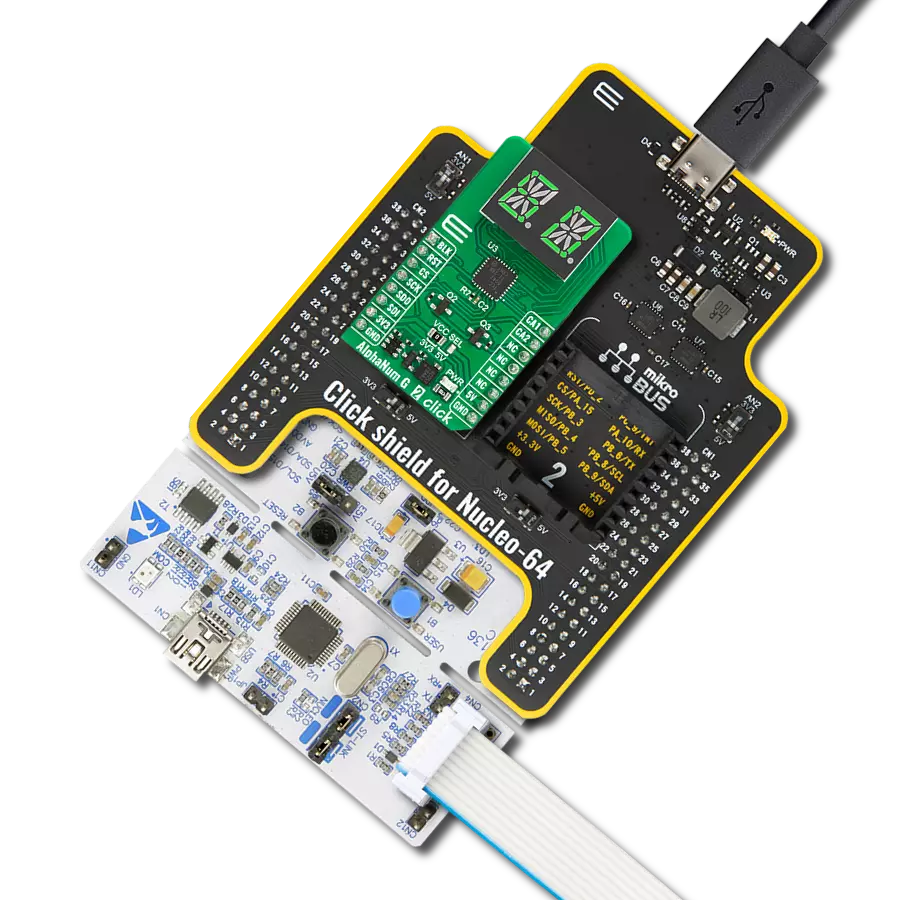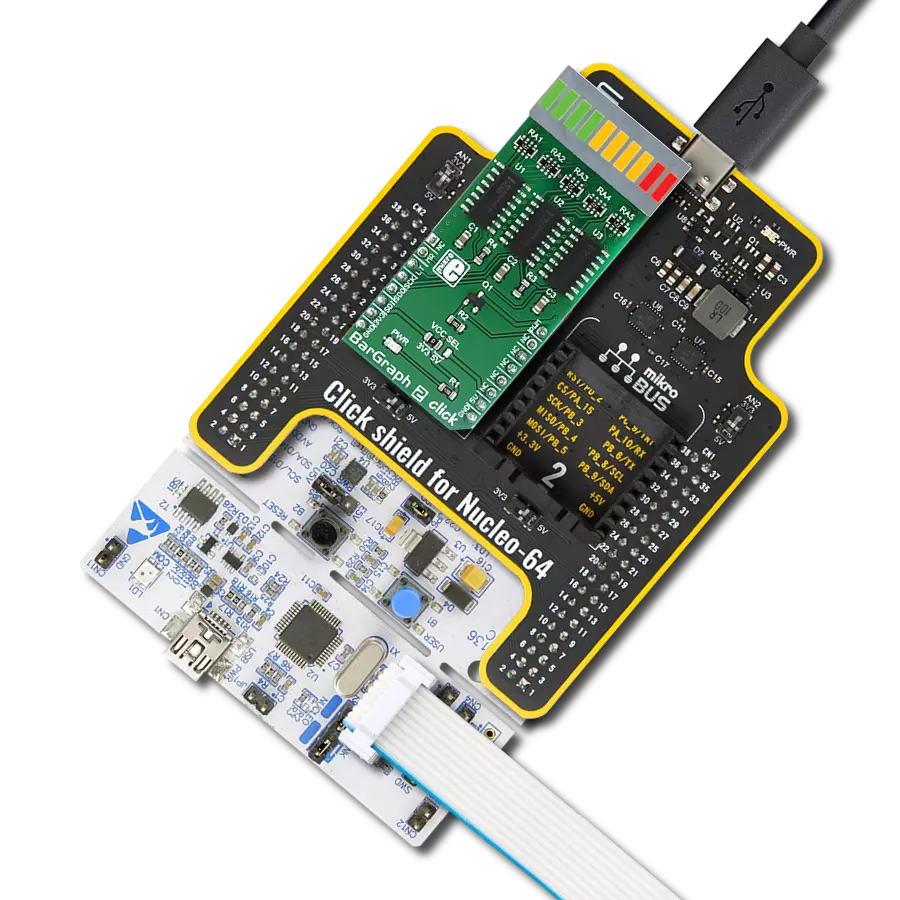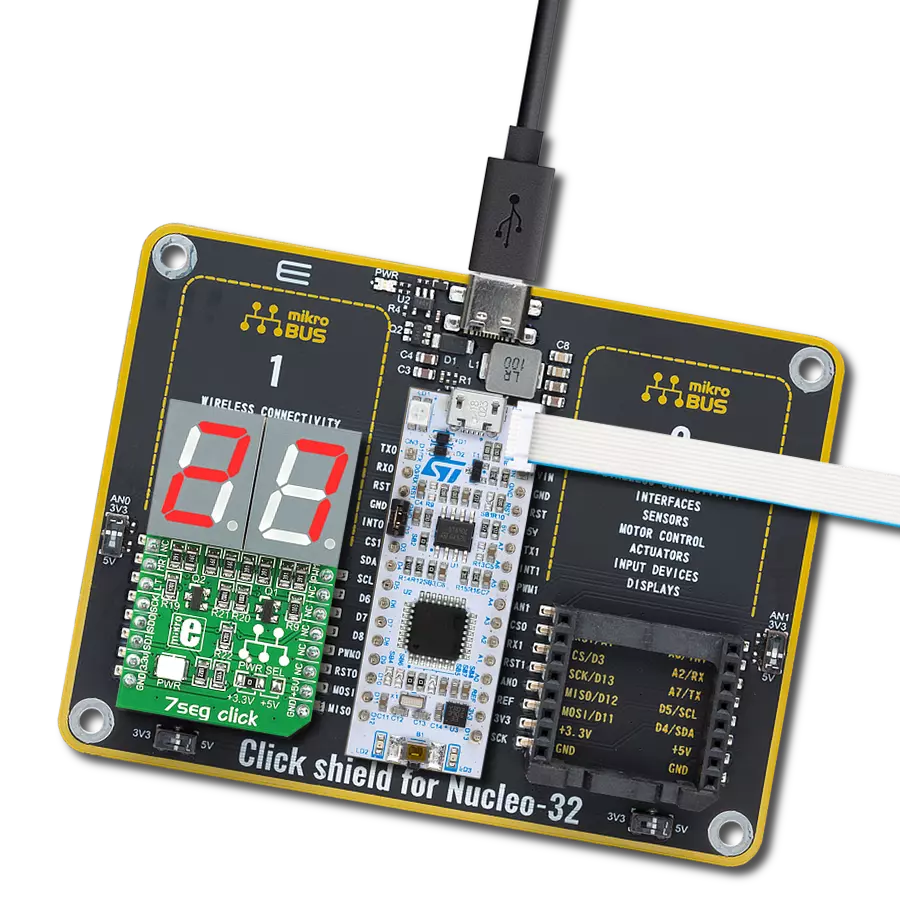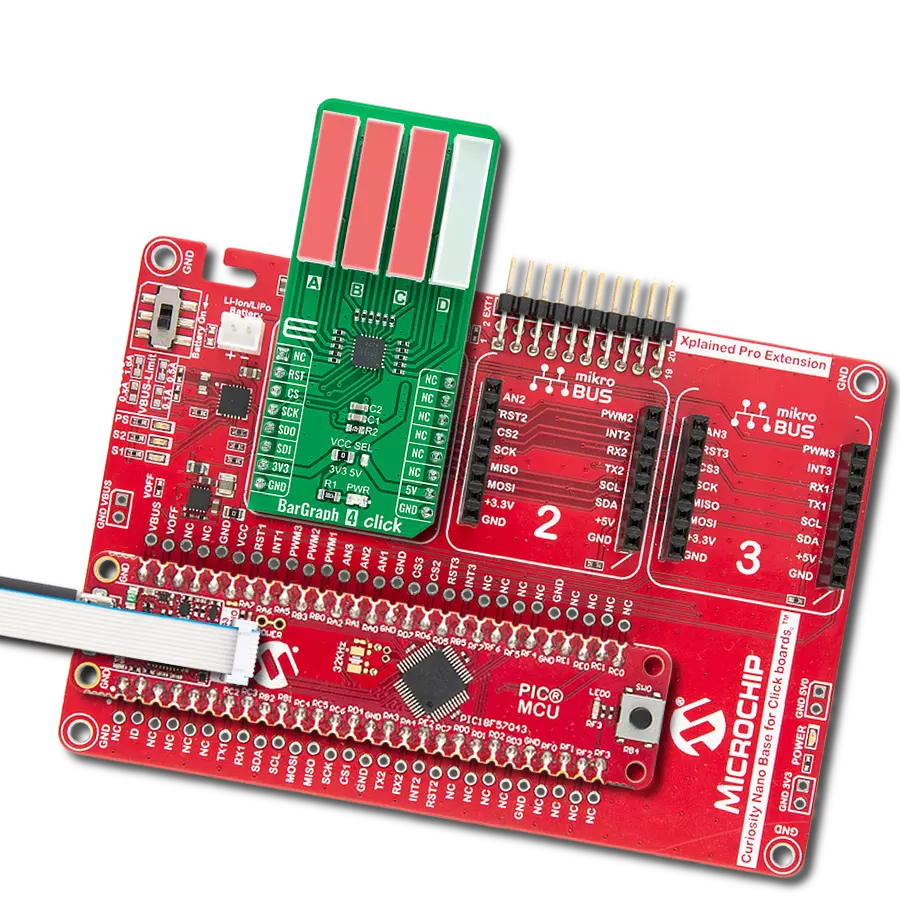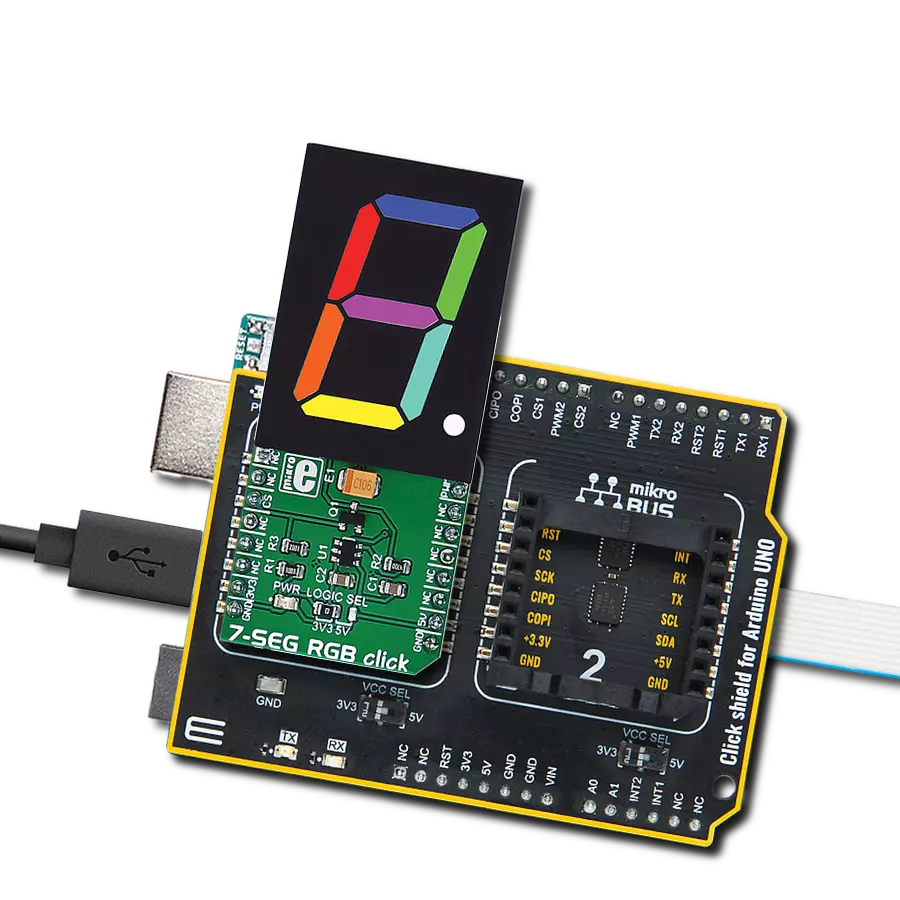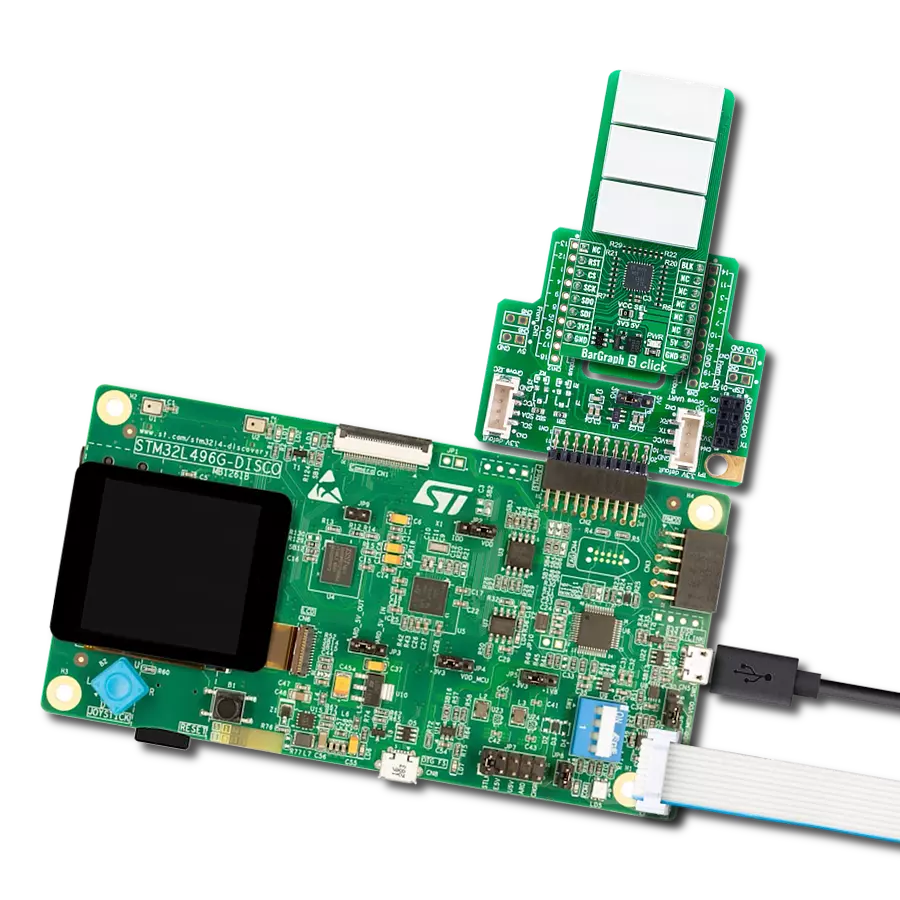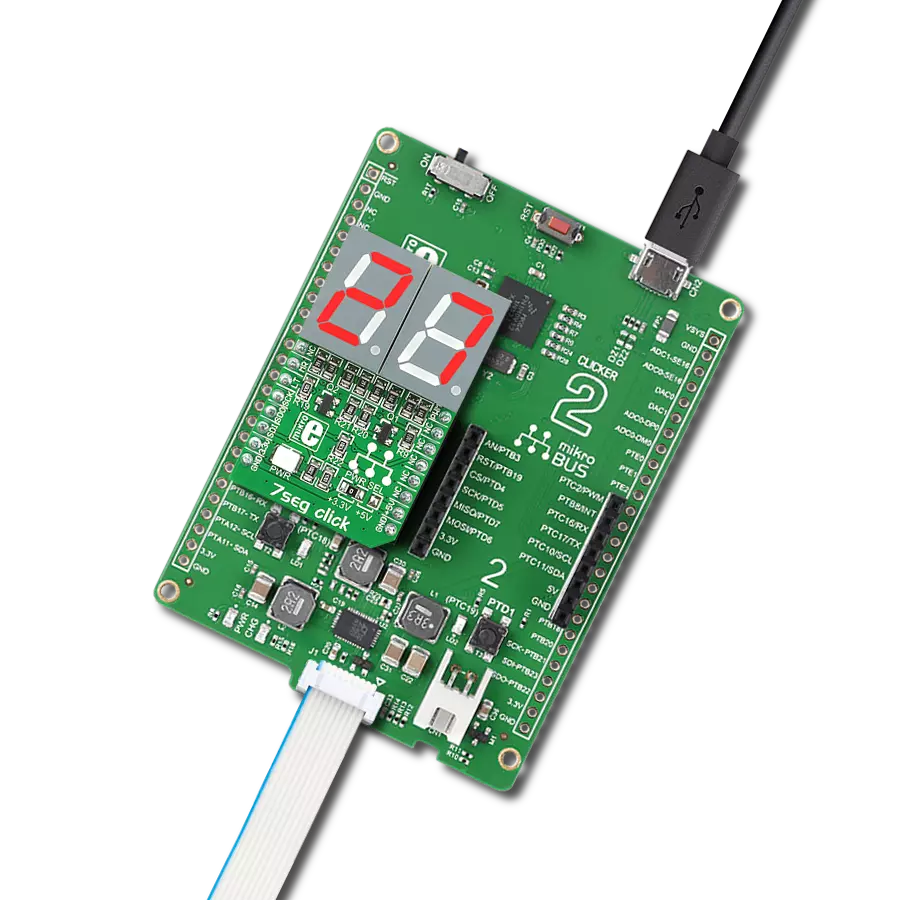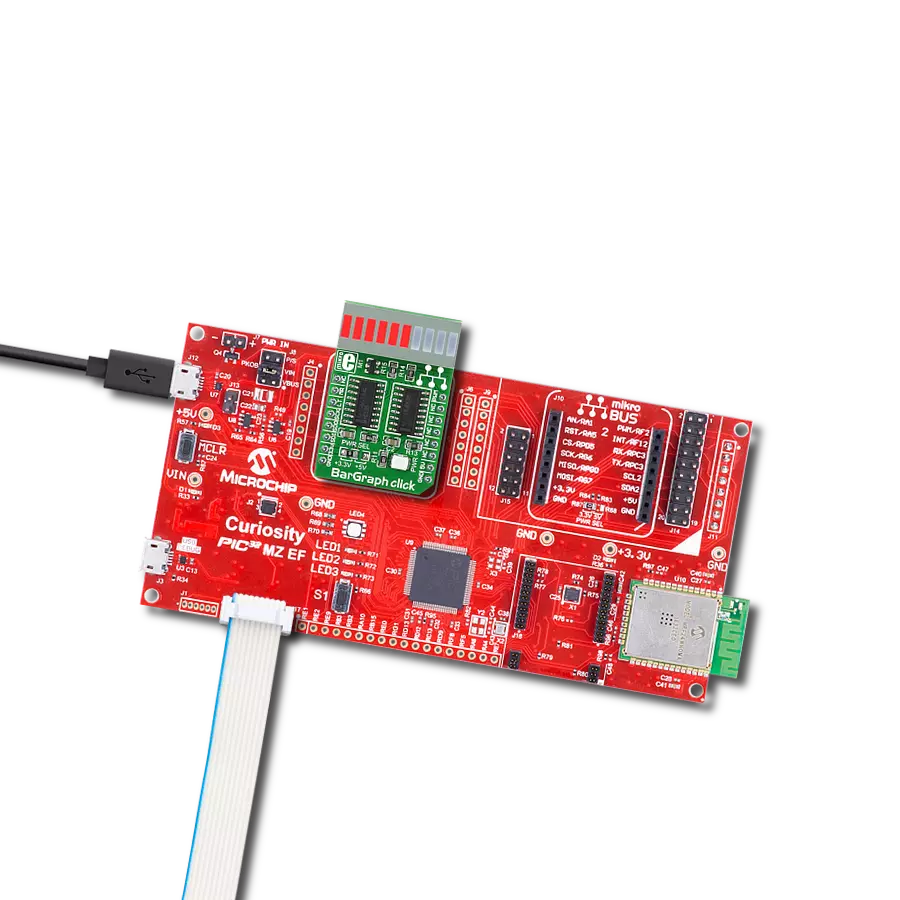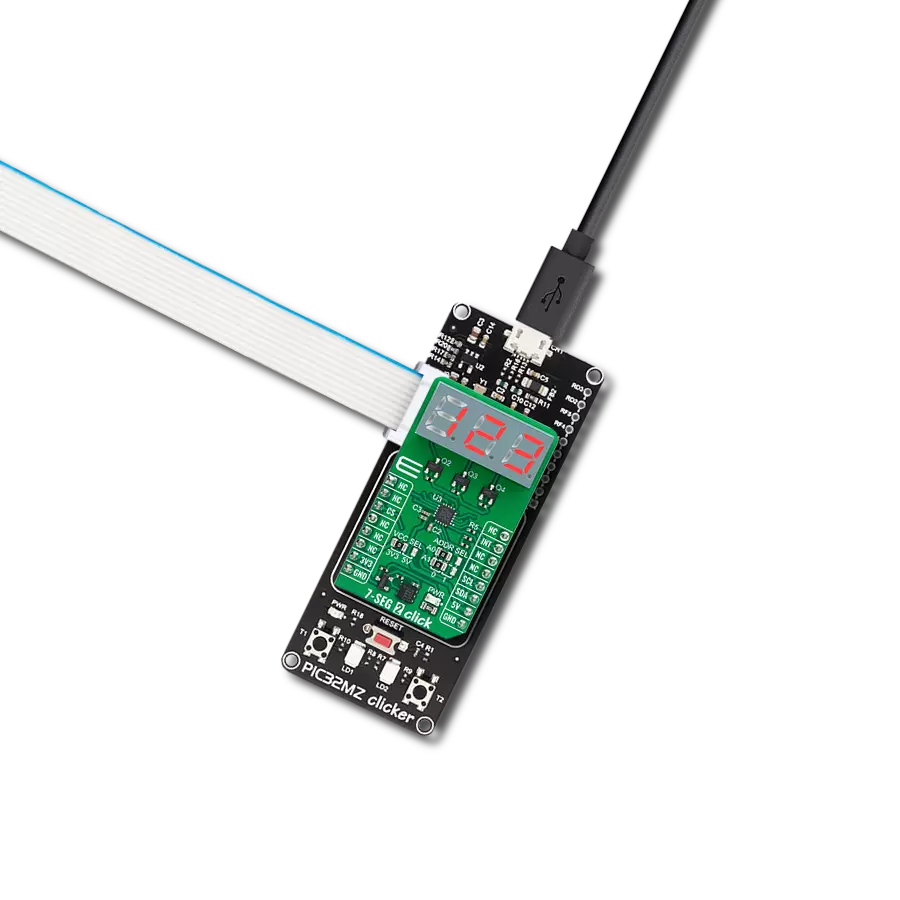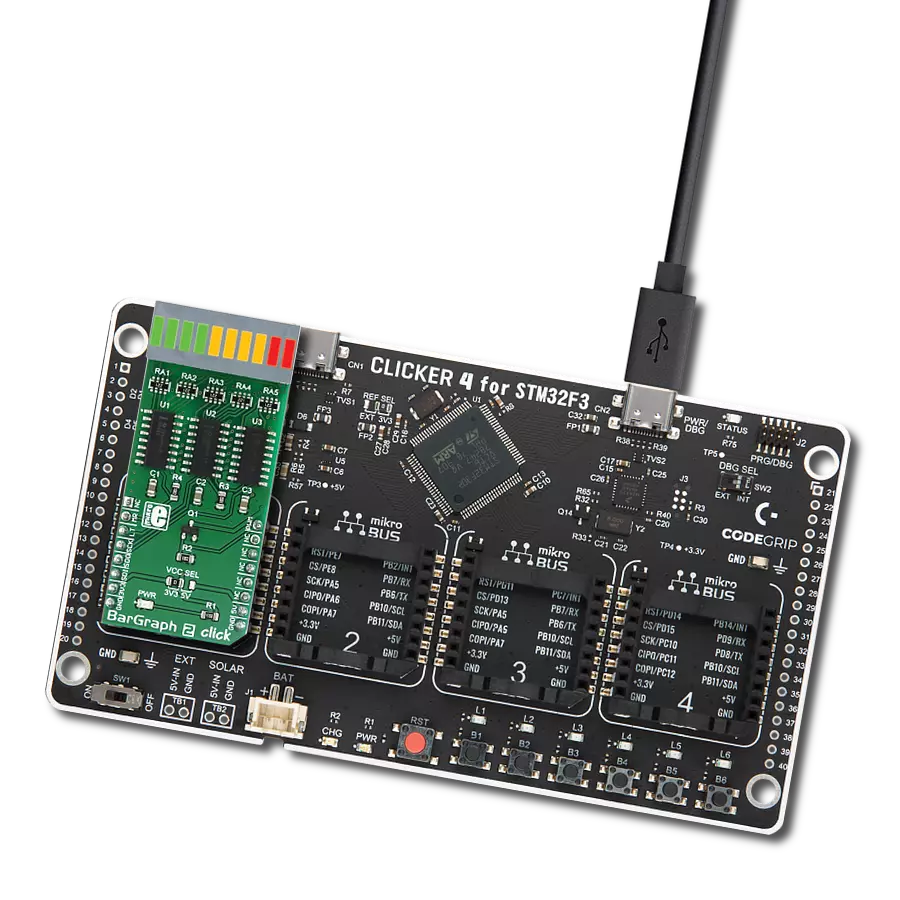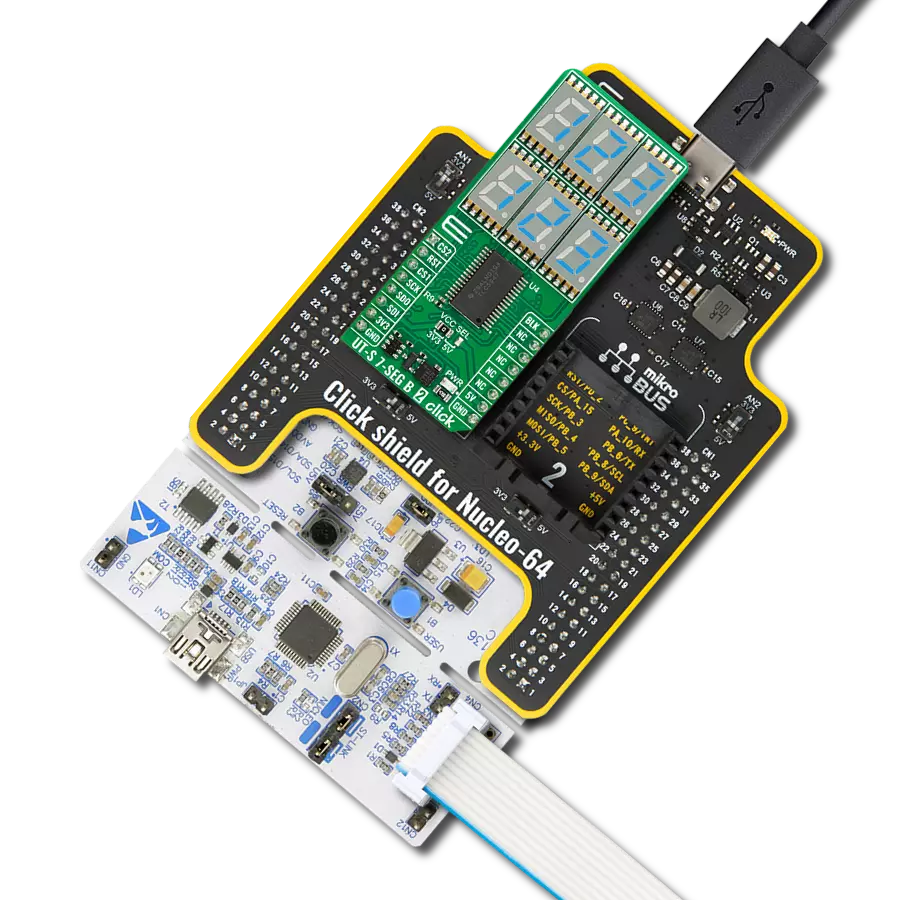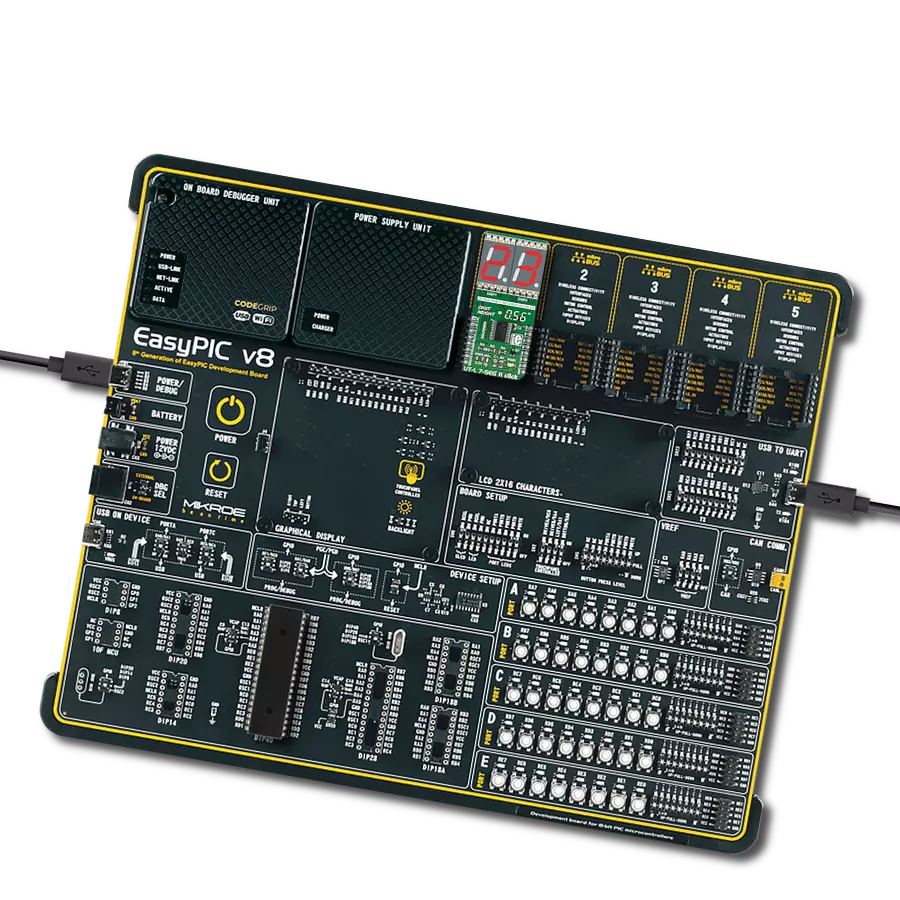Our seven-segment LED display is designed to illuminate information with clarity and precision, making it the ideal choice for all your numeric readout needs
A
A
Hardware Overview
How does it work?
BIG 7-Seg R Click is based on the SC10-21SRWA, a single-digit numeric display from Kingbright. This super bright red source color device is made with a Gallium Aluminium Arsenide red light-emitting diode. It features low current operation, high light output, excellent character appearance, and is mechanically rugged. The display works on 5V and has a common cathode as its internal design. It consists of seven red LED segments that form an 8 number and the eighth segment as a decimal point, or DP. The communication between the host MCU and the Big 7-Seg R Click is established via a 4-Wire SPI serial interface and the 8-bit
serial-IN, parallel-OUT 74HC595, a shifter register with 3-state output registers from Texas Instruments. The shift register provides a separate clock for both the shift and the storage register. In addition, you can set all shift register values to zero by applying logic LOW state on pin MR, and this function is independent of all clocks. One of the main features of the Big 7-Seg R Click is light intensity management. The light intensity can be set over the PWM pin. The SC10-21SRWA display is a 5V-only device. To work with 3.3V logic MCUs, this Click board™ features five SN74LVC1T45s, single-bit dual-supply bus transceivers with
configurable voltage translation, and 3-state outputs from Texas Instruments. These noninverting transceivers use two separate configurable power-supply rails and are designed for asynchronous communication between the two data buses. This Click board™ can operate with either 3.3V or 5V logic voltage levels selected via the DATA SEL jumper. This way, both 3.3V and 5V capable MCUs can use the communication lines properly. Also, this Click board™ comes equipped with a library containing easy-to-use functions and an example code that can be used as a reference for further development.
Features overview
Development board
PIC18F57Q43 Curiosity Nano evaluation kit is a cutting-edge hardware platform designed to evaluate microcontrollers within the PIC18-Q43 family. Central to its design is the inclusion of the powerful PIC18F57Q43 microcontroller (MCU), offering advanced functionalities and robust performance. Key features of this evaluation kit include a yellow user LED and a responsive
mechanical user switch, providing seamless interaction and testing. The provision for a 32.768kHz crystal footprint ensures precision timing capabilities. With an onboard debugger boasting a green power and status LED, programming and debugging become intuitive and efficient. Further enhancing its utility is the Virtual serial port (CDC) and a debug GPIO channel (DGI
GPIO), offering extensive connectivity options. Powered via USB, this kit boasts an adjustable target voltage feature facilitated by the MIC5353 LDO regulator, ensuring stable operation with an output voltage ranging from 1.8V to 5.1V, with a maximum output current of 500mA, subject to ambient temperature and voltage constraints.
Microcontroller Overview
MCU Card / MCU
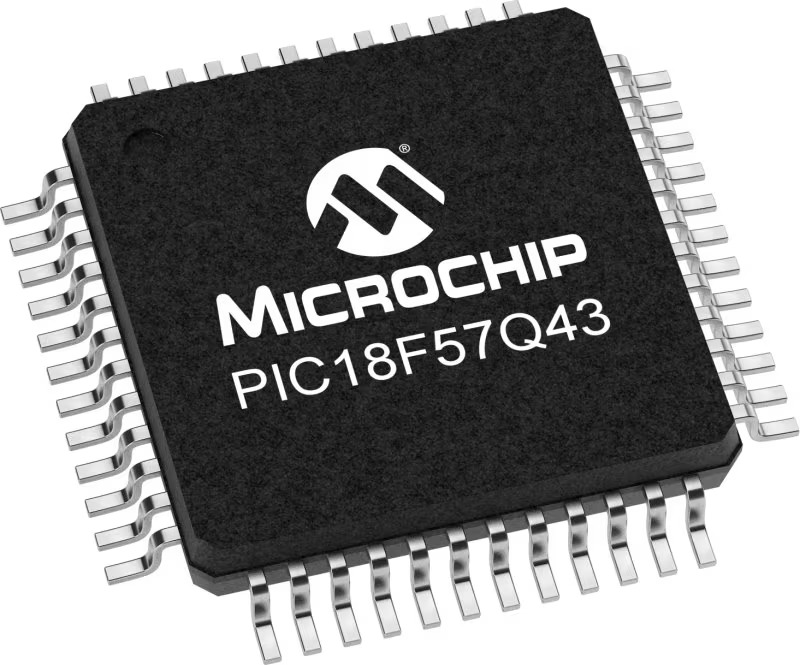
Architecture
PIC
MCU Memory (KB)
128
Silicon Vendor
Microchip
Pin count
48
RAM (Bytes)
8196
You complete me!
Accessories
Curiosity Nano Base for Click boards is a versatile hardware extension platform created to streamline the integration between Curiosity Nano kits and extension boards, tailored explicitly for the mikroBUS™-standardized Click boards and Xplained Pro extension boards. This innovative base board (shield) offers seamless connectivity and expansion possibilities, simplifying experimentation and development. Key features include USB power compatibility from the Curiosity Nano kit, alongside an alternative external power input option for enhanced flexibility. The onboard Li-Ion/LiPo charger and management circuit ensure smooth operation for battery-powered applications, simplifying usage and management. Moreover, the base incorporates a fixed 3.3V PSU dedicated to target and mikroBUS™ power rails, alongside a fixed 5.0V boost converter catering to 5V power rails of mikroBUS™ sockets, providing stable power delivery for various connected devices.
Used MCU Pins
mikroBUS™ mapper
Take a closer look
Click board™ Schematic
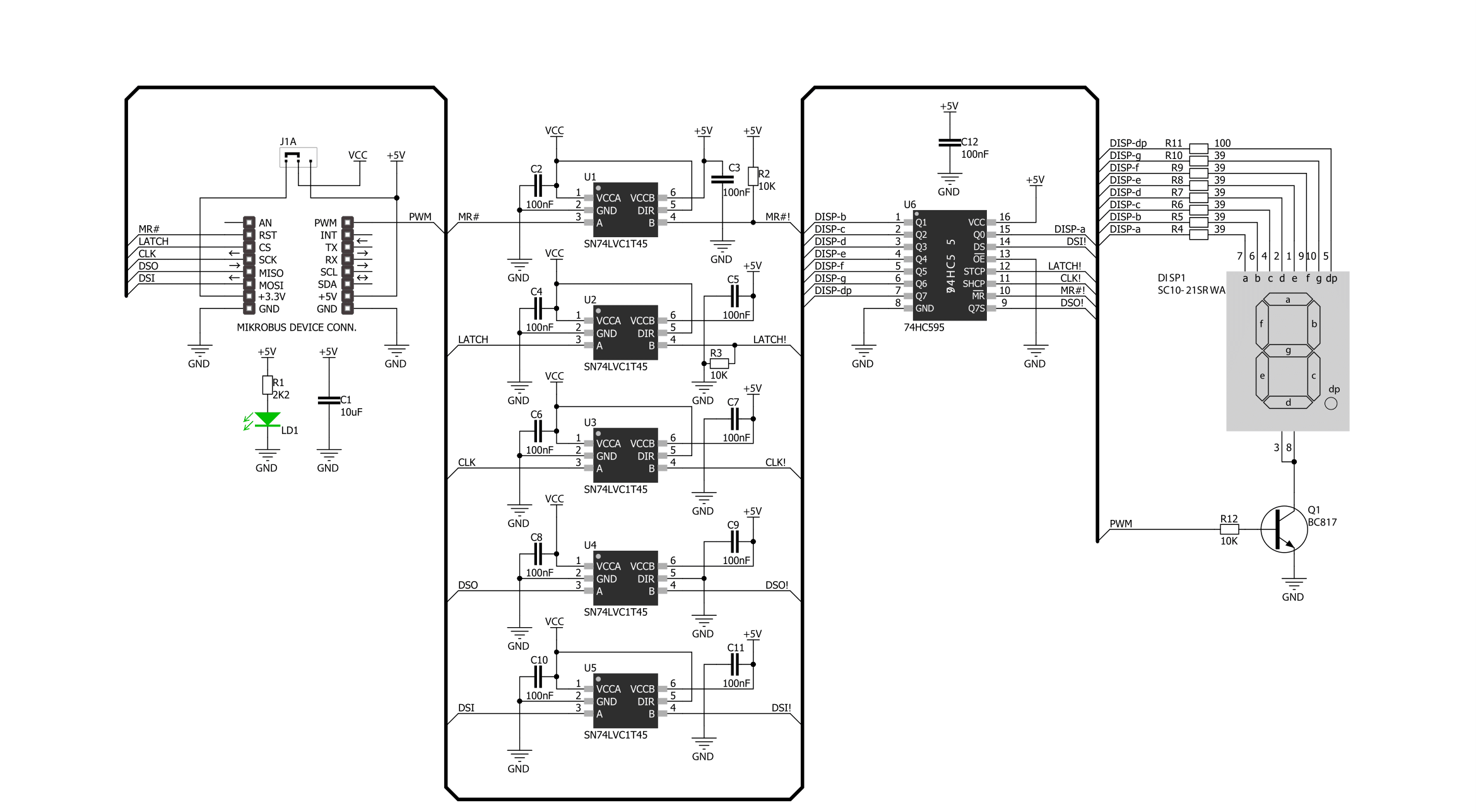
Step by step
Project assembly
Software Support
Library Description
This library contains API for BIG 7-SEG R Click driver.
Key functions:
big7seg_display_off- Turn OFF BIG 7-SEG displaybig7seg_write_data_number- Function write numberbig7seg_write_data_character- Function write character
Open Source
Code example
The complete application code and a ready-to-use project are available through the NECTO Studio Package Manager for direct installation in the NECTO Studio. The application code can also be found on the MIKROE GitHub account.
/*!
* \file
* \brief Big7Seg Click example
*
* # Description
* This application sets seven-segment leds on the display.
*
* The demo application is composed of two sections :
*
* ## Application Init
* Driver initializaion and turning on the display
* by setting PWM pin to logic 1 and prepare to communcation via SPI.
*
* ## Application Task
* This example shows functionality of the BIG 7-SEG R Click,
* shows number or character on display.
*
* \author MikroE Team
*
*/
// ------------------------------------------------------------------- INCLUDES
#include "board.h"
#include "log.h"
#include "big7seg.h"
// ------------------------------------------------------------------ VARIABLES
static big7seg_t big7seg;
static log_t logger;
// ------------------------------------------------------ APPLICATION FUNCTIONS
void application_init ( void )
{
log_cfg_t log_cfg;
big7seg_cfg_t cfg;
/**
* Logger initialization.
* Default baud rate: 115200
* Default log level: LOG_LEVEL_DEBUG
* @note If USB_UART_RX and USB_UART_TX
* are defined as HAL_PIN_NC, you will
* need to define them manually for log to work.
* See @b LOG_MAP_USB_UART macro definition for detailed explanation.
*/
LOG_MAP_USB_UART( log_cfg );
log_init( &logger, &log_cfg );
log_info( &logger, "---- Application Init ----" );
// Click initialization.
big7seg_cfg_setup( &cfg );
BIG7SEG_MAP_MIKROBUS( cfg, MIKROBUS_1 );
big7seg_init( &big7seg, &cfg );
big7seg_set7seg( &big7seg );
Delay_100ms( );
}
void application_task ( )
{
uint8_t counter;
big7seg_reset7seg( &big7seg );
big7seg_display_on( &big7seg );
Delay_1sec( );
big7seg_write_data( &big7seg, 0x40 );
Delay_1sec( );
big7seg_write_data_character( &big7seg, 'B' );
Delay_1sec( );
big7seg_write_data_character( &big7seg, 'I' );
Delay_1sec( );
big7seg_write_data_character( &big7seg, 'G' );
Delay_1sec( );
big7seg_write_data( &big7seg, 0x08 );
Delay_1sec( );
big7seg_write_data_number( &big7seg, 7 );
Delay_1sec( );
big7seg_write_data( &big7seg, 0x40 );
Delay_1sec( );
big7seg_write_data_character( &big7seg, 'S' );
Delay_1sec( );
big7seg_write_data_character( &big7seg, 'E' );
Delay_1sec( );
big7seg_write_data_character( &big7seg, 'G' );
Delay_1sec( );
big7seg_write_data( &big7seg, 0x00 );
Delay_1sec( );
for ( counter = 65; counter < 91; counter ++ )
{
big7seg_write_data_character( &big7seg, counter );
Delay_1sec( );
}
big7seg_display_off( &big7seg );
Delay_1sec( );
}
int main ( void )
{
/* Do not remove this line or clock might not be set correctly. */
#ifdef PREINIT_SUPPORTED
preinit();
#endif
application_init( );
for ( ; ; )
{
application_task( );
}
return 0;
}
// ------------------------------------------------------------------------ END
Additional Support
Resources
Category:LED Segment
